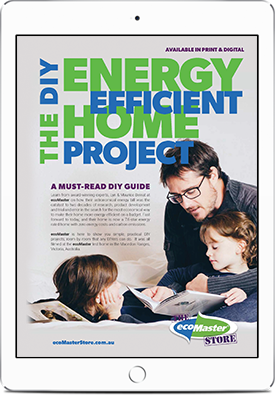#1 ENERGY PROBLEM
WANT TO DO SOMETHING ABOUT CLIMATE CHANGE
There is no argument that climate change is real and scientifically proven. We are starting to see some of the ways that is affects – the fires of 2019 / 2020 was a giant wake up call for many. The discussion needs to change to what can we do about it.
This is a issue close to our own hearts and the reason why we started ecoMaster. Global warning is such a big issue, the challenge is what can we do to make a sufficient difference.
1
Calculate your carbon footprint
Firstly we calculated our carbon footprint to see what we were dealing with. There are quite a few carbon footprint calculators available, so jump online and try at least two. You definitely want at least one of those to be quite detailed and go through your transport, shelter, food, and flight usage. That will give you a starting point and an idea of the scale of transition required.
Our worst result in our own carbon footprint calculation was for our home. It was nearly twice the national average. That had to change. Environmentally, socially, financially – it was not ok. So we embarked on 6 months of full-time research to determine what was the best way to reduce our carbon footprint on our home.
2
Analyse your energy bills
Look at your electricity and gas consumption, determine your standing charges (daily charges) and calculate that as a total. Understanding what tariff you are on and what you are paying gives you a good base to shop around and find the best deal. Plan on doing this research every two years (at least). It seems to be that loyal customers are rewarded by paying the highest energy bills.
3
Get off gas
If you are using gas, now is a great time to setup a clear path to switching from gas to a 100% electric home. Gas is being touted by some as a transition fuel. It is not. It is a fossil fuel and will continue to emit carbon emissions when burnt. It needs to stay in the ground.
Gas appliances cover hot water, heating and cooking. Regardless of the age of your appliances having a clear plan on what you would transition first, your replacement appliance of choice and possibly even the installer ensures you achieve optimal outcomes when the time comes to replace them.
Having a migration plan for each appliance will ensure that your next purchase will be the energy efficient you can afford by checking www.energyrating.gov.au. That website compares the energy efficiency of all appliances, so you aren’t hoodwinked by less than honest advertising.
After all, very few people make sensible decisions about hot water in a freezing cold shower in the middle of winter when they are trying to get ready for work.
4
Switch to renewable energy!
If the electricity from your retailer is not from 100% renewable sources, now would be a great time to make the switch! Then your carbon emissions from your home would be eliminated in one phone call. You could then call that “job done” to getting to a zero carbon home. But it will not make it more comfortable to live there.
If you prefer a more “hands on” approach to zero carbon as well… Read on.
5
The biggest consumer of energy in your home
On average, between 40% and 60% of a home’s energy costs can be attributed to heating and cooling. So the biggest difference you can achieve in a home is to reduce that usage and therefore that cost.
This does not mean turned down the thermostat and wearing a ski suit in your home. It means two things: (i) is the type of heating / cooling are you using optimal and (ii) deal with the thermal fabric of your home in a considered step-by-manageable-step approach.
Check your heating and cooling appliances for age, wear and life span. Once again, using www.energyrating.gov.au for guidance as to the most energy-efficient. If your heating/cooling is at the end of its life, it might be time for a considered replacement.
6
Start with the biggest issue first
Without doubt the best result for an investment in your home is effective draught-proofing. Start with the biggest gaps first, like chimneys, exhaust fans and vents, then move to doors and windows then smaller gaps and cracks. Effective draught-proofing can reduce your energy bills by 50% if your home was a draughty home.
Do not draught-proof a room that uses a gas appliance. The risk of carbon monoxide poisoning is real.
Some people aren’t sure where to start or not sure what to look for, so we offer a diagnostic service called ecoHome Air. (Link to assessment pages).
If you are a confident DIYers, then solutions can be found at www.ecoMasterStore.com.au
The Return on Investment for draught-proofing, in our experience, is a payback of 12 to 24 months. That is expressed directly in reduced energy costs. However, what isn’t factored in is your improved comfort. For some people, that is priceless.
7
Insulation
Everybody knows about insulation, but few people know much about it. Insulation is like a doona for your home. Without it you can’t possibly be warm (or cool in summer); it’s like trying to sleep on a cold night without a blanket. The trouble seems to be that lots of people associate insulation with those itchy fibreglass batts that they might have installed 10 or 20 years ago (or even longer) so they avoid checking out what they have and what condition it is in.
The good news is that there are clever folks who have recycled PET containers (milk and soft drink bottles) into the most beautiful polyester insulation that is completely people friendly and so snug. (I’ve even slept on it!). In fact, it is probably the same material that your pillows and doona are made from.

Without an effective and well-laid layer of insulation in your ceiling, you can’t possibly have an energy-efficient home, which means you are going to continue to pay high energy prices and still be cold in your home. 🙁
If you have timber floors, underfloor insulation will keep the aching cold out which means cosy toes for you every winter!
Wall insulation will complete the thermal efficiency puzzle of your home. It is much better for this to be done during construction, but in some homes, this can be done retrospectively.
8
Hot Water
Get on with installing your solar hot water system (around 25% of your energy bill) – either thermal solar or heat pump. Government rebates will play a part here, so do your research carefully.
9
Solar Power and Batteries
Once that is done, install solar panels on your roof sufficient to cover your (now significantly reduced) energy needs. So your home can power you. That will future proof your home from power bills forever as well as carbon emissions generated from your home, so you can get on with other things.
Many people start with a roof full of solar panels and then retrofit the rest of their home. You will need significantly less solar panels to power an energy-efficient home, so save those funds and invest in energy efficiency BEFORE energy generation.

Online Help?
Here is an online magazine that explains what we did to our home over the course of a few years to make it the haven that it is now.
NEXT STEPS?
If this is all too much and you want some hand holding along the journey, you can start off by getting a deep insight into your parent’s home’s overall energy efficiency performance. We conduct a thorough ecoHome Assessment in various areas in Victoria. From there, we will craft a specific home retrofit plan for you which you can perform in increments based on your budget, or all at once, or help you take an informed DIY path.
If DIY is your thing, you can discover more energy-efficient draught-proofing solutions that bring in maximum thermal comfort in the home without draining pockets! Shop for a wide range of excellent home retrofit solutions for greater thermal comfort at www.ecoMasterStore.com.au
To progress your journey towards an energy efficient home that loves your parents all year round and puts your mind at ease call 1300 326 627 or email: [email protected]

